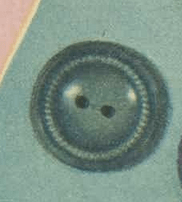Imitators
Since the 18th century, if not earlier, button manufacturers have used their ingenuity to fashion buttons from materials that are a cheaper substitute for more costly materials whilst having a similar appearance. A classic example of this were the cut steel buttons which were, to quote the 1991 edition of The Big Book of Buttons, ” .. originally conceived as a substitute for diamonds and their substitute, marcasite … ” . Glass buttons were made to imitate jet, fabric, passementerie, jewels, etc. In the modern era, plastics have been used to imitate probably all other materials, and also each other. In fact the developement of plastics was driven by the need to find substitutes for materials such as ivory and tortoiseshell, so you might say that imitation has been built into plastics DNA.
Beutron Style 212

These Beutron Opal-Glo buttons are moulded to represent fabric covered buttons with decorative stitching around the circumference. It is marked as ‘Style 212’. G. Herring, from the late 1940s-early 1950s made a point of labeling the style numbers of their buttons on some cards, an effort no other firm bothered with. I wonder why they did?
Below is a detail from a 1950 advert of this style of button.

For all comments, contributions and questions, please use the Contact page.
